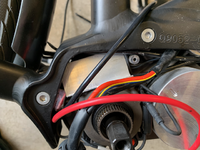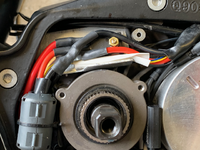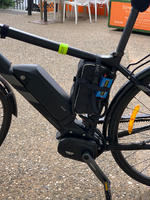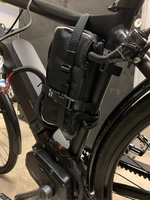Hi, New here. But others may be interested in an experiment I am running.
A while back (2018?) I bought two Avanti Inc. E bikes - Avanti is a New Zealand Brand common in Australia and the inc E (at that time) was equipped with Shimano Steps 6000 drive line, hydraulic disc brakes, Alfine 8 speed hub and Gates CDX belt drive. At the time was top spec and a good price.
So one bike has been sold (mine after 6,000km) and I kept the wife's (600km) for myself. But in this time both batteries basically would get to 25 to 30% State Of Charge (SOC) and then drop to nothing in a very short time/distance. Both batteries were replaced under warranty. The bike sold thus had effectively a new battery. The bike I have now - some time later - is showing the same symptoms but is well out of warranty now. The battery is a AUD900 thing to replace if it gets worse. Even worse - how long will they be available to buy.
So what to do about this?
So I thought - add a second battery. 36volt approx. ~10AH batteries are approx. 1/3 the price of the genuine battery. My thinking is that as long as the motor control electronics can communicate with the genuine battery (and the bar mount controller) then the "system" should still operate blissfully unaware of the second battery - even if the Shimano battery is basically dying - as long of the SOC is above the cutoff - the second battery can still be used to run the bike.
I will say upfront I am not trying to maintain the same SOC in both batteries. I have another motive here as hinted at above.
I used a common cathode Schottky diode array (MBR6045WT) summing both batteries into the motor controller (meaning batteries cannot discharge into each other) and the results are:
So in summary, a successful experiment to date.
I intend to deliberately run the cheap second battery at a higher SOC (recharge often) than the Shimano battery (recharge much less often) thus this second battery carries most of the work load - thus lengthening the lifetime of the stock Shimano battery. If I want increased range, I will charge both up to 100% SOC.
This same "hack" is probably possible with other Shimano engine / battery combinations.
Some photos of the diode array fitment are attached
A while back (2018?) I bought two Avanti Inc. E bikes - Avanti is a New Zealand Brand common in Australia and the inc E (at that time) was equipped with Shimano Steps 6000 drive line, hydraulic disc brakes, Alfine 8 speed hub and Gates CDX belt drive. At the time was top spec and a good price.
So one bike has been sold (mine after 6,000km) and I kept the wife's (600km) for myself. But in this time both batteries basically would get to 25 to 30% State Of Charge (SOC) and then drop to nothing in a very short time/distance. Both batteries were replaced under warranty. The bike sold thus had effectively a new battery. The bike I have now - some time later - is showing the same symptoms but is well out of warranty now. The battery is a AUD900 thing to replace if it gets worse. Even worse - how long will they be available to buy.
So what to do about this?
So I thought - add a second battery. 36volt approx. ~10AH batteries are approx. 1/3 the price of the genuine battery. My thinking is that as long as the motor control electronics can communicate with the genuine battery (and the bar mount controller) then the "system" should still operate blissfully unaware of the second battery - even if the Shimano battery is basically dying - as long of the SOC is above the cutoff - the second battery can still be used to run the bike.
I will say upfront I am not trying to maintain the same SOC in both batteries. I have another motive here as hinted at above.
I used a common cathode Schottky diode array (MBR6045WT) summing both batteries into the motor controller (meaning batteries cannot discharge into each other) and the results are:
- It works. Putting a wattmeter in series with the new battery shows it IS contributing and from the bar controller display the rate of SOC reduction in the main battery is visibly slowed.
- Powering on the second battery will power on the eBike.
- The eBike will not power off via the bar mounted controller unless the second battery is switched off before doing this (I use a 30A circuit breaker for this).
- If the main battery is at say 50 to 60% SOC and the second battery is at 100% SOC, the SOC on the Shimano display does not change for a LONG time as the second battery is effectively running the bike. In my case this is the target - great for main battery longevity. The second battery is CHEAP - can be recharged often with no concern - thus reducing the re-charge cycles for the Shimano battery.
- The bike is more powerful - higher assist being provided. A watt meter in series with the second battery when the second battery has a higher SOC than the Shimano battery (supplying all the current) shows up to 400W peak power and up to 11amp peak being delivered to the motor. Average is lower eg 300 to 350Watt. This has implications I was not initially aware of:
- The "250Watt" Shimano Steps 6000 motor seems to be more than 250W capable when not run using the stock battery. Hence the wattmeter is in play until I figure out what is going on.
- The heatsink I designed for the Schottky diode array was sized as a compromise between 7amp continuous and it fitting inside the plastic motor casing - I may have to do some extra work here now higher currents thus higher heating is occuring.
- There is now a risk of blowing the Shimano motor controller if these power levels are real. This is a WARNING for others that play in a similar manner. For me an annoyance only if it occurs - I have a spare (new) motor bought for USD100 some time back - I have already checked that it works on this bike.
I intend to deliberately run the cheap second battery at a higher SOC (recharge often) than the Shimano battery (recharge much less often) thus this second battery carries most of the work load - thus lengthening the lifetime of the stock Shimano battery. If I want increased range, I will charge both up to 100% SOC.
This same "hack" is probably possible with other Shimano engine / battery combinations.
Some photos of the diode array fitment are attached
- The heavy power cables fit between the rear of the motor and the Avanti frame quite neatly.
- The heatsink is sitting on top of the light controller module. Yes it all fits - just!
- The second battery is a bit ugly at present - the blue wattmeter will be removed once I am confident of what is going on and a smaller SOC meter will be mounted up front.
- The circuit breaker sits below the second battery.







